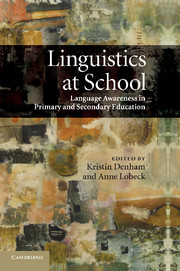Book contents
- Frontmatter
- Contents
- Notes on contributors
- Foreword: The challenge for education
- Introduction
- Part I Linguistics from the top down: encouraging institutional change
- Part II Linguistics from the bottom up: encouraging classroom change
- Introduction to Part II
- 9 From cold shoulder to funded welcome: lessons from the trenches of dialectally diverse classrooms
- 10 Positioning linguists as learners in K-12 schools
- 11 Fostering teacher change: effective professional development for sociolinguistic diversity
- 12 On promoting linguistics literacy: bringing language science to the English classroom
- 13 Linguistics in a primary school
- 14 Educating linguists: how partner teaching enriches linguistics
- 15 The Linguistic Olympiads: academic competitions in linguistics for secondary school students
- Part III Vignettes: voices from the classroom
- References
- Index
13 - Linguistics in a primary school
Published online by Cambridge University Press: 04 August 2010
- Frontmatter
- Contents
- Notes on contributors
- Foreword: The challenge for education
- Introduction
- Part I Linguistics from the top down: encouraging institutional change
- Part II Linguistics from the bottom up: encouraging classroom change
- Introduction to Part II
- 9 From cold shoulder to funded welcome: lessons from the trenches of dialectally diverse classrooms
- 10 Positioning linguists as learners in K-12 schools
- 11 Fostering teacher change: effective professional development for sociolinguistic diversity
- 12 On promoting linguistics literacy: bringing language science to the English classroom
- 13 Linguistics in a primary school
- 14 Educating linguists: how partner teaching enriches linguistics
- 15 The Linguistic Olympiads: academic competitions in linguistics for secondary school students
- Part III Vignettes: voices from the classroom
- References
- Index
Summary
Introduction
In this chapter, I discuss a linguistics course that I taught for about three years in a multi-age primary school classroom and how what started as a simple “guest spot” in a school evolved into a bigger project with broader applications. I demonstrate ways in which I, along with the primary teachers, integrated linguistics into the curriculum (into language arts, social studies, science, and even a bit into math).
It has long been recognized that K-12 teachers can benefit from linguistic knowledge. Linguists in the US began to recognize the importance of some of the findings of their field to K-12 education in the 1960s and 1970s, which led to several projects designed to determine which aspects of linguistics might be best incorporated into K-12 curriculum and how to undertake that incorporation. O'Neil (Chapter 2 in this volume) describes a 1962 US Office of Education project, strongly supported by the National Council of Teachers, called Project English. Keyser (1970) offers lesson plans that were part of a Massachusetts Department of Education project to integrate linguistics into K-12 curricula. Though these projects came to an end for various reasons, discussed elsewhere in this volume, a handful of linguists have continued to work at incorporating linguistics into K-12 classrooms.
More recently, Chomsky et al. (1985), Fabb (1985), Goodluck (1991), Honda (1994), Wolfram (1997), and Reaser and Wolfram (2005) have all demonstrated that linguistics activities are successful and beneficial in K-12 education.
- Type
- Chapter
- Information
- Linguistics at SchoolLanguage Awareness in Primary and Secondary Education, pp. 189 - 203Publisher: Cambridge University PressPrint publication year: 2010
- 4
- Cited by



